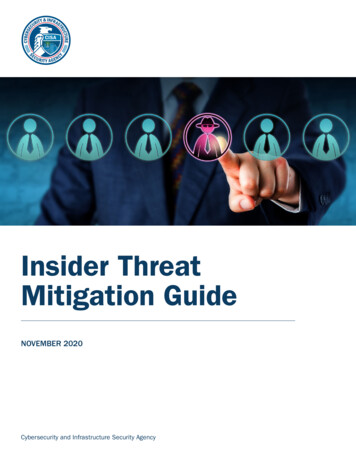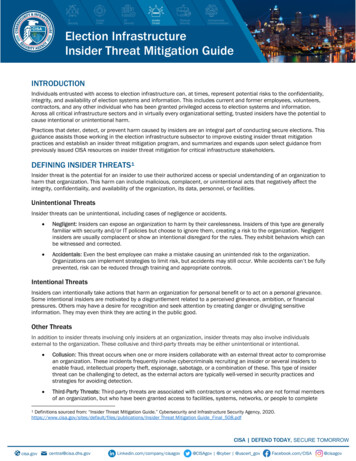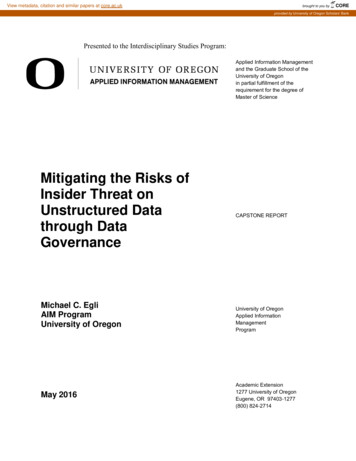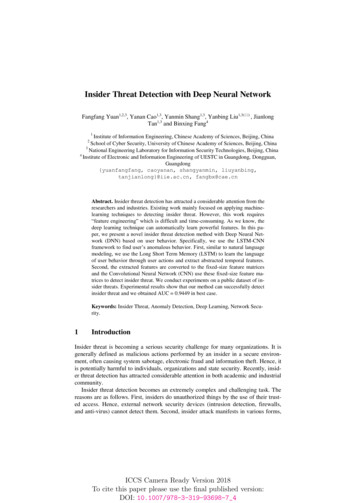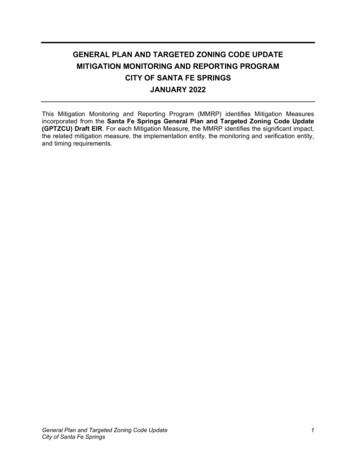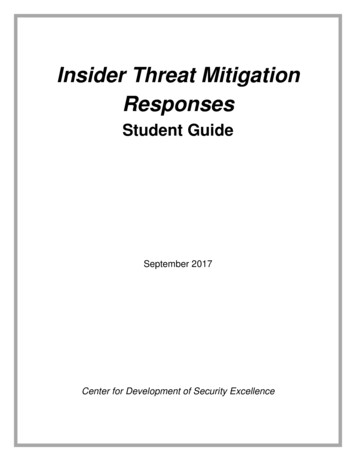
Transcription
Insider Threat MitigationResponsesStudent GuideSeptember 2017Center for Development of Security Excellence
Insider Threat Mitigation ResponsesStudent GuideLesson 1: Course IntroductionIntroductionWelcomeWhile Insider Threat Programs may identify individuals committing espionage or othernational security crimes, not all incidents will result in the arrest of a spy. In fact, InsiderThreat Programs resolve most cases before they escalate into negative events through theproactive identification of individuals at risk of harming the organization—either wittingly orunwittingly—and the deployment of alternative mitigation options. This allows the InsiderThreat Program to protect information, facilities, and personnel—and to retain valuableemployees.Welcome to the Insider Threat Mitigation Responses course! This course describes theability of multidisciplinary insider threat teams to craft tailored and effective responses tospecific behaviors or issues.Multidisciplinary insider threat teams are comprised of subject matter experts from: Law yMental health/behavioral scienceHuman resourcesLegalCase StudyConsider the case of Bryan Minkyu Martin. Martin’s excessive gambling and other habits lefthim in debt. He frequently borrowed money from coworkers and exhibited increasinglystressed behavior. Ultimately he attempted to sell national security information to a foreigngovernment. Luckily, in this instance, the FBI interceded with a sting operation before anyinformation could actually be transmitted. Martin was sentenced to 34 years in prison,reduced in rank, forfeited all pay and allowance, and received a dishonorable dischargefrom the Navy. After his arrest, he stated that others were aware of his risky behavior andthat if only the information had been reported he might have been stopped before attemptingto betray his country.A printable case study is available at the end of this Student Guide.September 2017Center for Development of Security ExcellencePage 1-1
Insider Threat Mitigation ResponsesStudent GuideObjectivesHere are the course objectives. Take a moment to review them. Explain the role of Insider Threat Programs in mitigating the risks posed by insiderthreats and how Programs mitigate those risks Describe factors to consider when formulating a mitigation response to an insiderthreat incident Summarize the ability of multidisciplinary teams to craft mitigation responses tailoredto insider threat incidents Identify reporting requirements that apply to Insider Threat ProgramsSeptember 2017Center for Development of Security ExcellencePage 1-2
Insider Threat Mitigation ResponsesStudent GuideLesson 2: Mitigation OverviewIntroductionWelcomeHad Bryan Martin’s actions been reported early, an Insider Threat Program could haveemployed alternative response options to mitigate the threat. When identified early, InsiderThreat Programs can often resolve common workplace issues, such as personal problems,financial issues, and even disgruntlement. This results in positive outcomes for both theindividual and the organization.ObjectivesHere are the lesson objectives. Take a moment to review them. Describe the critical pathway model of insider threat and how it applies to mitigatingthe threat Explain the role of Insider Threat Programs in mitigating the risks posed by insiderthreats and how Programs mitigate those risksThe Critical PathwayPotential Risk IndicatorsMartin’s behavior and activities are examples of potential risk indicators (PRIs). PRIs areobservable and reportable behaviors and activities that may be exhibited by those at risk ofbecoming an insider threat. Specific PRIs come from a variety of sources in the security andintelligence communities and may be specific to your organization.PRIs share general characteristics with the adjudicative guidelines, which someorganizations use to determine insider threat risk. PRIs generally belong to the categorieslisted here: Access attributes Professional lifecycle and performance Foreign considerations Security compliance and incidents Technical activity Criminal, violent, or abusive conduct Financial considerationsSeptember 2017Center for Development of Security ExcellencePage 2-1
Insider Threat Mitigation Responses Substance abuse and addictive behaviors Judgment, character, and psychological conditionsStudent GuideBehavioral Model of Insider ThreatDr. Eric Shaw, clinical psychologist and consultant to Federal agencies on insider crime,originated the “critical pathway” model for understanding insider attacks. The components ofthe model are:1. Personal Predispositions2. Stressors3. Concerning Behaviors4. Insider Threat-Like BehaviorIt begins with personal predispositions and personal and professional stressors, which areoften the behaviors that emerge as PRIs. Over time, these factors may combine andincrease the risk that an individual may become an insider threat.Consider the Bryan Martin case. Martin’s excessive gambling demonstrated a personaltendency toward risk-taking and fed directly into his financial stressors. Compounding thesituation, Martin experienced personal stress, wanting to impress his fiancée’s father. Thesestressors led to concerning behavior by Martin, including frequently borrowing money fromfriends and colleagues. All of these factors culminated in Martin seeking information beyondhis need-to-know and copying and removing classified materials from the workplace in amisguided attempt to alleviate his problems.The model also demonstrates that there are multiple opportunities to redirect individuals onthe pathway into more positive behaviors. For example, if Martin had help with his gamblingor his financial issues, his behavior may not have escalated. Early intervention can meanthe difference between rehabilitation and negative escalation of behavior.Role of Insider Threat ProgramsOverviewInsider Threat Programs fulfill four functions. First, they deter potential insider threats byinstituting appropriate security countermeasures, including awareness programs. Next, theydetect individuals at risk of becoming insider threats and then mitigate the risks thoseindividuals pose before the issue escalates. Finally, Insider Threat Programs reportinformation about actual or potential insider threats. Early detection and intervention are thekeys to mitigating risks, as demonstrated by the critical pathway model.Let’s examine these in greater detail.September 2017Center for Development of Security ExcellencePage 2-2
Insider Threat Mitigation ResponsesStudent GuideDetectionDetection of PRIs typically occurs through reporting by personnel and monitoring conductedby the Program. Once detected, the PRI becomes the catalyst for Insider Threat Programactivities, including information gathering, analysis, reporting, and response.InterventionThe deployment of mitigation options, or your organization’s “response” to the insider threat,depends on multiple variables and the unique nature of the insider threat. The mitigationstrategy may include referral outside of the Insider Threat Program when required or actionsto mitigate the risk internally.Note that while some insider threat incidents may warrant referrals and intervention from lawenforcement, not all meet reporting thresholds or result in an arrest.In most cases, proactive mitigation responses provide positive outcomes for theorganization and the individual. This allows the organization to protect information, facilities,and personnel and to retain valuable employees, and offers intervention to alleviate theindividual’s stressors and guide them off the critical pathway.Effective MitigationAccording to the critical pathway model, without intervention, risky behavior may escalate,causing potential damage to national security, personnel, facilities, or other resources. To beeffective, Insider Threat Programs must be attentive to potential issues before they pose athreat, have a risk assessment process in place, address potential issues adequately, andtake actions that minimize risk while avoiding those that escalate risk.September 2017Center for Development of Security ExcellencePage 2-3
Insider Threat Mitigation ResponsesStudent GuideReview ActivitiesReview Activity 1What does the critical pathway model demonstrate?Select the best response. Then check your answer in the Answer Key at the end of thisStudent Guide. Everyone with personal issues is an insider threat and must be monitored closely forthe escalation of behavior. Personal predispositions and stressors can lead to the escalation of behavior unlessthe individual’s stressors are alleviated. An individual displaying potential risk indicators should be permitted to escalate inbehavior until arrest and prosecution are viable.Review Activity 2How do Insider Threat Programs mitigate risks posed by insider threats?Select all that apply. Then check your answers in the Answer Key at the end of this StudentGuide. Detect issues early Follow a risk assessment process Adequately address potential issues Refer all issues to law enforcementSeptember 2017Center for Development of Security ExcellencePage 2-4
Insider Threat Mitigation ResponsesStudent GuideLesson 3: Response PlanningIntroductionWelcomeInsider Threat Programs must carefully plan their mitigation responses to avoid escalation ofrisk and to engender a thorough and measured approach to the initiation of punitive action.ObjectivesHere are the lesson objectives. Take a moment to review them. Identify the primary tenets in responding to insider threat matters List possible consequences of inappropriate mitigation responses Describe factors to consider when formulating a mitigation response to an insiderthreat incidentResponse BasicsOverviewInsider Threat Programs must follow five primary tenets when planning responses to insiderthreat incidents, the most important of which is “first, do no harm.” Insider Threat programsmust also establish and maintain internal procedures and authorities, avoid alerting theindividual that they have been identified as a potential insider threat, protect the individual’sprivacy and civil liberties, and preserve chain of custody and properly handle evidence.Let’s examine these in greater detail.First, Do No HarmWhen an insider threat incident occurs, your Insider Threat Program must carefully assessthe situation to avoid exacerbating the situation or increasing risk. Consider whether there isimminent danger to the individual or to others and whether there is an active transmittal ofclassified information. The Insider Threat Program must thoroughly plan its response beforetaking action and avoid knee-jerk responses. When planning, communicate and coordinatewith your Insider Threat Program team members and other organizational elements.Establish and Maintain Procedures and AuthoritiesYour Insider Threat Program must ensure that it has detailed procedures and authorities inplace for mitigation response options and should maintain a general response plan thatSeptember 2017Center for Development of Security ExcellencePage 3-1
Insider Threat Mitigation ResponsesStudent Guideoutlines the overall roles and responsibilities of Insider Threat Program personnel and Hubmembers or other staff and departments.Avoid Alerting the IndividualIn general, your Insider Threat Program should avoid alerting the individual that they havebeen identified as a potential insider threat. This allows the Program the time needed todetermine an appropriate response, ensures the privacy of the individual, and preservesevidence. Note that in some cases immediate intervention may be required.Protect Privacy & Civil LibertiesYour Insider Threat Program must consider the individual’s privacy and civil liberties whendeveloping mitigation response options. Ensure that personal information is properlyhandled, accessed, used, reported, and retained in accordance with applicable laws,policies, and regulations.Preserve Chain of Custody and EvidenceYour Insider Threat Program must ensure that early actions taken in incident response donot interfere with the ability of law enforcement or counterintelligence to conductinvestigations or operations, or inhibit future prosecution, in cases that require reporting toexternal agencies. Work with your general counsel and the referral agency to ensure thatany evidence associated with the incident is handled properly and adheres to the properchain of custody.The Preserving Investigative and Operational Viability in Insider Threat course offersadditional information if you would like to learn more. You may register for this coursethrough the Center for Development of Security Excellence (CDSE) website.Unintended ConsequencesImpactsYour Insider Threat Program’s response to insider threat indicators or incidents can havelong-reaching effects. Even seemingly viable solutions may have inadequate or negativeimpacts on the individual, on the morale of other personnel, on the mission of yourorganization, and on public perception of your organization.IndividualsPossible negative impacts on individuals include disgruntlement due to an overlyaggressive response that makes the individual feel poorly treated, which increases risk,and effects to the career or life of the individual due to poor information handling thatpersists even if the individual is exonerated of wrongdoing or was falsely accused.September 2017Center for Development of Security ExcellencePage 3-2
Insider Threat Mitigation ResponsesStudent GuideMoralePossible negative impacts on the morale of other personnel include disgruntlementthroughout the organization if others learn of an overly aggressive response. This mayresult in reduced vigilance and hesitancy to report. Overly weak responses may alsodeter reporting, as it may make personnel feel that it is pointless to report indicators. Inaddition, seeing a colleague charged with or convicted of a crime, even when it isnecessary, may impact morale.MissionA possible negative impact on the mission of the organization includes personnel thatcircumvent the rules to get their work done due to onerous rule or procedure changes atthe organization level.Public PerceptionA possible negative impact on public perception of your organization includes low moraleand diminished future recruitment capability due to media coverage on the situation andyour response.Threat AnalysisOverviewInsider Threat Programs must take the time to perform the proper gathering and analysis ofdata before taking action. If an indicator has a plausible explanation and does not increasethe risk associated with an individual, an immediate reaction may do more harm than good.Conversely, even if the risk associated with an individual is elevated, it is not necessarily aprecursor to a national security crime or act of violence. An immediate response in theseinstances may compromise the ability of law enforcement and counterintelligence to pursueinquiries, investigations, or operations.Let’s take a closer look at the considerations to keep in mind during threat analysis.Analysis GoalThe Insider Threat Program should begin by establishing the goal of analysis. Whatquestions is the team trying to answer? State your purpose clearly and in multiple ways toclarify meaning and scope, and consider breaking the problem down into smaller pieces.For example, consider these large questions that Insider Threat Programs work to resolve: Is the individual currently harming the organization’s resources? If so, is the harm intentional? Is there a risk that the individual will do so in the future?September 2017Center for Development of Security ExcellencePage 3-3
Insider Threat Mitigation ResponsesStudent GuideBreaking these into smaller questions can help you to grasp and manage your goal.When formulating questions, aim to be clear and precise. Anything is possible, so bespecific. A clear and precise question might be to consider whether it is possible that theindividual stole classified information.Focus on questions that are significant, answerable, and relevant, such as, “Did theindividual have access to the safe? Does the individual display unexplained affluence?”Finally, differentiate between questions that have a definitive answer, are a matter ofopinion, and require consideration of multiple viewpoints. The question, “Were theindividual’s credentials used to log onto the system on a specific date?” has a definitiveanswer, while the question, “Was the individual upset?” is a matter of opinion. While theanswer may be relevant and the Program can aggregate the opinions of multiple people todraw a conclusion, the answer is subjective. Also consider whether other viewpoints mightreveal a plausible explanation for an indicator. For example, late night activity on aninformation system may seem suspicious, but the cybersecurity subject matter expert mayidentify the activity as a common practice of batch patching and updates scheduled to occurwhen the system is at its lowest usage.Fair and Balanced AssessmentInsider Threat Programs must also strive toward a fair and balanced assessment of eachcase. To do so, first identify and acknowledge your assumptions. Consider whether they arejustifiable and how they shape your point of view. Next, seek other points of view andevaluate their merits. Finally, ground all claims with the information available. Ensure thatyour position is supported by the evidence and is based on relevant information. Criticallyevaluate your position to determine whether you have considered all of the relevantinformation, whether your conclusion goes beyond the evidence available, and whetherthere is an argument to be made against your position.With these considerations in mind, review the example real-world threat analysis case studybelow.ExampleThe Federal Bureau of Investigation (FBI) knew they had a spy in their midst—but whowas it? As the FBI conducted their investigation, they felt sure that the spy could not beone of their own, so they identified Brian Kelley, a CIA agent, as their suspect. Theyinvestigated Kelley, including a polygraph and a sting operation, both of which Kelleypassed. Rather than conclude that perhaps Kelley was not a spy, the FBI took this asevidence that Kelley was an able, well-trained spy.Eventually, the FBI acquired intelligence information that identified the true spy asRobert Hanssen, a long-time FBI counterintelligence agent who is now considered themost damaging spy in FBI history. However, until the FBI identified Hanssen, Kelley hadSeptember 2017Center for Development of Security ExcellencePage 3-4
Insider Threat Mitigation ResponsesStudent Guidebeen investigated for years and his career was nearly destroyed. Meanwhile, Hanssencontinued to spy and place national security at risk for over 20 years.How much sooner might the FBI have identified the true threat if the investigators hadconsidered how the assumption that the spy must be CIA influenced their perspective,sought multiple viewpoints, and regarded the evidence available that opposed theirviewpoint?September 2017Center for Development of Security ExcellencePage 3-5
Insider Threat Mitigation ResponsesStudent GuideReview ActivitiesReview Activity 1How well do you understand the primary tenets of responding to insider threat matters?For each statement, select whether it is true or false. Then check your answers in theAnswer Key at the end of this Student Guide.It is better to act quickly than to take the time to thoroughly plan a response. True FalseInsider Threat Programs should maintain detailed procedures and authorities. True FalseThe Insider Threat Program should notify individuals when they have been identified as apotential insider threat. True FalseReview Activity 2Leanne’s organization terminated her employment after she mistakenly left classifiedinformation on the printer. It was her first security violation. Which of the following arepossible consequences of this response?Select all that apply. Then check your answers in the Answer Key at the end of this StudentGuide. Impacts on Leanne’s career Disgruntlement throughout the organization Other personnel less willing to report indicators Impacts on recruitment of new employeesSeptember 2017Center for Development of Security ExcellencePage 3-6
Insider Threat Mitigation ResponsesStudent GuideReview Activity 3Which of the following best describes the considerations for formulating an insider threatmitigation response?Select the best response. Then check your answer in the Answer Key at the end of thisStudent Guide. Establish a goal, seek opinions, ask broad questions, consider arguments for andagainst each position Establish a goal, acknowledge assumptions, consider other viewpoints, baseconclusions on the evidence Act immediately, break the problem into manageable pieces, assume the simplestexplanation is most likely to be accurateSeptember 2017Center for Development of Security ExcellencePage 3-7
Insider Threat Mitigation ResponsesStudent GuideLesson 4: Multidisciplinary Mitigation ResponsesIntroductionObjectivesMultidisciplinary insider threat teams are uniquely positioned to craft mitigation responsestailored to specific insider threat incidents.Multidisciplinary insider threat teams are comprised of subject matter experts from: Law yMental health/behavioral scienceHuman resourcesLegalHere are the lesson objectives. Take a moment to review them. Differentiate between organizational and individual responses Summarize the ability of multidisciplinary teams to craft mitigation responses tailoredto insider threat incidentsTypes of ResponsesOrganizational and IndividualResponses to insider threat incidents may be organizational, individual, or both.Organizational responses address a systemic problem with security procedures, training,hiring practices, policies, or other procedures that increase the risk associated with theinsider threat. Individual responses address a specific incident and are designed to mitigatethe risk associated with or harm caused by a specific individual. In some cases, anorganizational response may be effective in addition to or in place of an individual response.Organizational ResponseExamples of organizational responses: Changing policy or Standard Operating Procedures (SOP) throughout theorganization Disabling thumb drives across the organization to prevent downloading sensitiveinformationSeptember 2017Center for Development of Security ExcellencePage 4-1
Insider Threat Mitigation Responses Instituting random bag checks Introducing metal detectors Providing training or briefings to:oIncrease awareness of tactics used by adversariesoPrevent individuals from becoming unwitting insider threatsStudent GuideIndividual ResponseExamples of individual responses: Internal referrals to human resources or security Referral to counterintelligence or law enforcement for inquiry, investigation, oroperation Referral to counseling, such as mental health or financial Punitive actions, such as revocation of access or termination of employmentTailored Multidisciplinary Mitigation ResponsesOverviewThe multidisciplinary nature of Insider Threat Programs allows them to craft responsestailored to specific behaviors. A multidisciplinary team working together can provide the mosteffective responses, which often include a multi-faceted implementation that may include amix of organizational and individual responses that cover multiple disciplines.To learn more about the disciplines that comprise a multidisciplinary insider threat team,refer to the Developing a Multidisciplinary Insider Threat Capability course. You may registerfor this course through the Center for the Development of Security Excellence (CDSE)website.Human Resources (HR)Example response options specific to human resources: Referral to the Employee Assistance Program (EAP) for resources in financialcounseling, lending programs, mental health, and other well-being programs Medical referrals Mediation with supervisors Training Employee termination procedures Other career opportunitiesSeptember 2017Center for Development of Security ExcellencePage 4-2
Insider Threat Mitigation ResponsesStudent GuideCybersecurityExample response options specific to cybersecurity: Reduce privileges or system access Reconfigure hardware, such as to prevent the use of thumb drives or discburning Limit downloadable file size Limit or prevent printing Conduct training and awareness campaigns on phishing and other cybertargeting methods Increase monitoringSecurityExample response options specific to security: Log a security violation or infraction Provide security counseling, training, or awareness Implement daily bag checks Implement random drug and alcohol testing Conduct physical monitoring Modify Standard Operating Procedures (SOP)Counterintelligence (CI)Example response options specific to counterintelligence: Referral to the cognizant CI activity for inquiry, investigation, or operation aswarranted Provide training on foreign targeting methods and recruitment Develop a foreign travel brief/debrief program Provide threat awareness materialsLaw Enforcement (LE)Example response options specific to law enforcement: Referral to the cognizant LE activity for inquiry or investigation as warranted Provide criminal threat briefings and awareness materialsSeptember 2017Center for Development of Security ExcellencePage 4-3
Insider Threat Mitigation ResponsesStudent GuideMental Health/Behavioral ScienceExample response options specific to mental health and behavioral science: Treatment recommendations Referral to marital, grief, or other mental health counseling Referral to substance abuse rehabilitation programs Referral to suicide preventionLegalBe sure to include legal in the development of response options to ensure the potentialresponse aligns with privacy protection requirements and other policies.Response MonitoringOnce the Insider Threat Program implements a mitigation response, it must monitor theresponse to determine if the risk has been minimized. Note that implementing a mitigationresponse option does NOT eliminate risk.Coordinate with your Insider Threat Program partners to determine whether additionalmitigation is required. Keep in mind that law or policy may prevent some partners fromsharing information with the Program. These may include Employee Assistance Programs,law enforcement, and counterintelligence. As such, the Insider Threat Program shouldremain vigilant for additional or escalating indicators and document behaviors or activities ofconcern.Finally, be sure to periodically re-evaluate the mitigation response to determine if it remainsthe best option.Case StudyRecall Bryan Martin, who attempted to sell classified information to alleviate his financialtroubles. Let’s assume for a moment that a colleague reported Martin’s financial problemsearly on rather than allow his behavior to escalate. What mitigation responses might amultidisciplinary Insider Threat Program have used to proactively redirect Martin away fromthe critical pathway?Some possible mitigation responses that may have applied to the Martin case include acombination of: Referral to financial counseling to help Martin get his debt under control (individualresponse; HR) Referral to gambling addiction resources to help him get the behavior causing thedebt under control (individual response; Mental Health/Behavioral Science)September 2017Center for Development of Security ExcellencePage 4-4
Insider Threat Mitigation Responses Student GuideReducing or limiting the ability of personnel within the organization to print orphotocopy classified information (organizational response; Cybersecurity) Instituting daily bag checks within the organization (organizational response;Security)Note that mitigation responses are not a one-size-fits-all solution. No two insider threatincidents are alike, even when similar potential risk indicators are present, so be sure yourteam evaluates each incident on a case-by-case basis.September 2017Center for Development of Security ExcellencePage 4-5
Insider Threat Mitigation ResponsesStudent GuideReview ActivitiesReview Activity 1For each mitigation response, select whether it is an organizational or individual response.Then check your answers in the Answer Key at the end of this Student Guide.Referral to counterintelligence or law enforcement Organizational IndividualConduct training and awareness campaigns Organizational IndividualIssue a security violation Organizational IndividualTerminate employment Organizational IndividualReview Activity 2How do multidisciplinary insider threat teams craft tailored mitigation responses?Select all that apply. Then check your answers in the Answer Key at the end of this StudentGuide. Employ response options from multiple disciplines Appoint a discipline to determine the best response depending on the incident Use a mix of individual and organizational responses Maintain a standardized approach to common types of insider threat incidentsSeptember 2017Center for Development of Security ExcellencePage 4-6
Insider Threat Mitigation ResponsesStudent GuideLesson 5: Reporting RequirementsIntroductionObjectivesInsider Threat Programs must report certain types of information. This lesson describesreporting requirements for DoD, Federal, and industry Insider Threat Programs.Here is the lesson objective. Take a moment to review it. Identify reporting requirements that apply to Insider Threat ProgramsReportingOverviewDoD, Federal agency, and industry Insider Threat Programs operate under differentregulations and requirements for reporting. When reporting, your Program may need tocease its activities, such as when the referral agency initiates an inquiry or investigation. Inother instances, the Program
Insider Threat Mitigation Responses Student Guide September 2017. Center for Development of Security Excellence. Page 1-1 . Lesson 1: Course Introduction . Introduction . Welcome . While Insider Threat Programs may identify individuals committing espionage or other national security crimes, not all incidents will result in the arrest of a spy.

